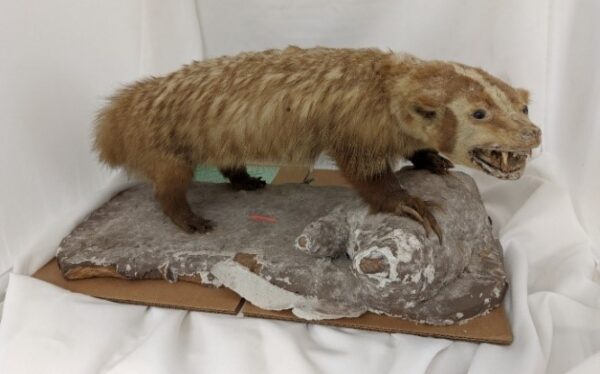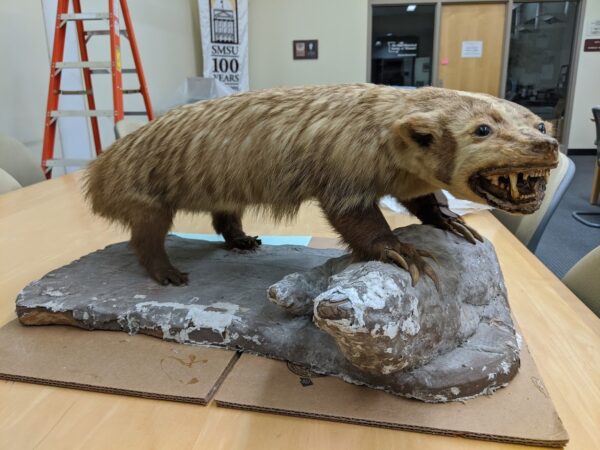
Taxidermy badger (Taxidea taxus)
Ozarks culture
20th century
Hide, fur, tow, bones, teeth, claws, wood and paper; L. 56 cm x W. 37 cm x H. 26 cm
Christian County Museum collection #2019.3

Taxidermy badger (Taxidea taxus)
Ozarks culture
20th century
Hide, fur, tow, bones, teeth, claws, wood and paper; L. 56 cm x W. 37 cm x H. 26 cm
Christian County Museum collection #2019.3
American badgers are stocky, solitary creatures with large, sharp claws that enable them to dig burrows for their homes as well as to dig into the burrows of their prey, which include insects, rodents, and snakes. They live in grasslands, prairies, fields, and pastures from western North America to Ohio, and from the central Canadian provinces down to the mountains of Mexico; accordingly, they have been found in Missouri prairies, grasslands, and croplands, but they are a relatively rare sight today because of habitat destruction. Because they consume many pests, because their burrows help with soil development, and because their old burrows often become homes for other animals, badgers have historically been important to ecosystems. Interestingly, badgers and coyotes have been seen hunting together: As the badger digs underground and scares small rodents from their burrows, coyotes above-ground pursue the rodents as they flee.
Badgers are also important in Native American folklore, but different cultures emphasize different character traits of the badger. Among the Wabanaki, the badger is described as an irresponsible trickster, and stories are told to discourage children from acting in this manner. Some scholars suspect that this story may be the result of poor translation, however, as wolverines are widely seen to embody these qualities, and Europeans are known to have confused the words for wolverines and badgers. Given that the range of the American badger does not reach into the historical territories of the Wabanaki, these stories likely instead referred to the wolverine.
Among the Wabanaki and the Apache, the badger is a much different character who is responsible and resourceful, and stories of the badger are told to encourage children to emulate these qualities. North American Native symbolism also supports this positive characterization of the badger, as badgers often symbolize protection and legends suggest that the badger warned others of danger and helped to avert disasters. Because of their digging, badgers also symbolize husbandry and agriculture, supporting the idea that the animal is a protector and a provider. In addition, among Zuni mythology in the American Southwest, the badger is one of the wemawe, the gods positioned at the compass points and that protect the world.
Among the European cultures that moved into the American Midwest and West, badgers were often trapped for their fur. This thick, luxurious fur was used as trim for outerwear and for other items like shaving brushes and paintbrushes. This taxidermy badger is believed to have been captured in the 1970s and then mounted as a memento or a trophy; it was donated to the Christian County Museum collections in 1979.
For more information, you may contact the researcher(s) noted in the title of this exhibit entry, or Dr. Billie Follensbee, the professor of the course, at BillieFollensbee@MissouriState.edu

